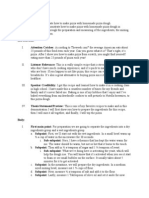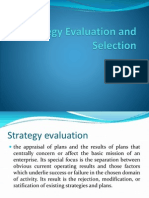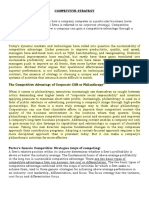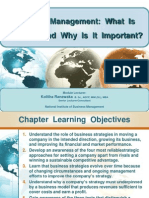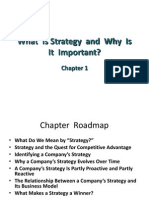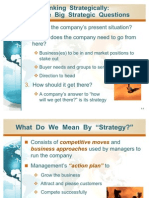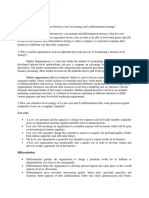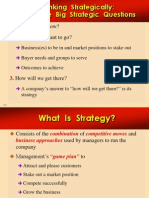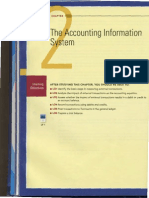0 ratings0% found this document useful (0 votes)
58 viewsChapter 1
Chapter 1
Uploaded by
Huy TranThe document discusses the definition and importance of strategy for companies. It outlines different strategic approaches like low-cost, differentiation, and hybrid strategies. It also discusses how strategies evolve over time in response to changes in the competitive environment and a company's situation. An effective strategy fits the company's resources and environment to achieve competitive advantage and strong performance.
Copyright:
© All Rights Reserved
Available Formats
Download as DOCX, PDF, TXT or read online from Scribd
Chapter 1
Chapter 1
Uploaded by
Huy Tran0 ratings0% found this document useful (0 votes)
58 views4 pagesThe document discusses the definition and importance of strategy for companies. It outlines different strategic approaches like low-cost, differentiation, and hybrid strategies. It also discusses how strategies evolve over time in response to changes in the competitive environment and a company's situation. An effective strategy fits the company's resources and environment to achieve competitive advantage and strong performance.
Original Description:
Nite
Copyright
© © All Rights Reserved
Available Formats
DOCX, PDF, TXT or read online from Scribd
Share this document
Did you find this document useful?
Is this content inappropriate?
The document discusses the definition and importance of strategy for companies. It outlines different strategic approaches like low-cost, differentiation, and hybrid strategies. It also discusses how strategies evolve over time in response to changes in the competitive environment and a company's situation. An effective strategy fits the company's resources and environment to achieve competitive advantage and strong performance.
Copyright:
© All Rights Reserved
Available Formats
Download as DOCX, PDF, TXT or read online from Scribd
Download as docx, pdf, or txt
0 ratings0% found this document useful (0 votes)
58 views4 pagesChapter 1
Chapter 1
Uploaded by
Huy TranThe document discusses the definition and importance of strategy for companies. It outlines different strategic approaches like low-cost, differentiation, and hybrid strategies. It also discusses how strategies evolve over time in response to changes in the competitive environment and a company's situation. An effective strategy fits the company's resources and environment to achieve competitive advantage and strong performance.
Copyright:
© All Rights Reserved
Available Formats
Download as DOCX, PDF, TXT or read online from Scribd
Download as docx, pdf, or txt
You are on page 1of 4
Chapter 1: What is Strategy and why is it important?
What do you mean by Strategy?
Strategy:
o The set of actions that its managers take to outperform the companys
competitors and achieve superior profitability.
o Competitive success and profits in the short run lasting success that can
support growth and secure the companys future over the long term.
A coherent array of well-considered choices about how to compete:
o How to attract and please customers.
o How to compete against rivals.
o How to position the company in the marketplace and capitalize on
attractive opportunities to grow the business.
o How to respond to changing economic and market conditions.
o How to manage each functional piece of the business (R&D, supply chain
activities, production, sales and marketing, distribution, finance, and
human resources).
o How to achieve the companys performance targets.
Some companies opt for wide product lines, while others concentrate their
energies on a narrow product line up.
Some competitors deliberately confine their operations to local or regional
markets; others opt to compete nationally, internationally (several countries), or
globally (all or most of the major country markets worldwide).
Strategy is about competing differently
Every companys strategy needs to have some distinctive element that draws in
customers and produces a competitive edge.
Strategy, at its essence, is about competing differently, doing what rival firms
dont do or what rival firms cant do.
A strategy stands a better chance of succeeding when it is predicated on actions,
business approaches, and competitive moves aimed:
o Appealing to buyers in ways that set a company apart from its rivals
o Staking out a market position that is not crowded with strong competitors.
A companys strategy provides direction and guidance.
Strategy and the Quest for competitive advantage
There are many routes to competitive advantage, but they all involve either
giving buyers what they perceive as superior value compared to the offerings of
rival sellers or giving buyers the same value as others at a lower cost to the firm.
Superior value can mean a good product at a lower price, a superior product that
is worth paying more for, or a best-value offering that represents an attractive
combination of price, features, quality, service, and other attributes.
Delivering superior value or delivering value more efficientlywhatever form it
takesnearly always requires performing value chain activities differently than
rivals do and building competencies and resource capabilities that are not readily
matched.
What makes a competitive advantage sustainable (or durable), as opposed to
temporary, are elements of the strategy that give buyers lasting reasons to
prefer a companys products or services over those of competitors reasons that
competitors are unable to nullify or overcome despite their best efforts.
o A company achieves a competitive advantage when it provides buyers
with superior value compared to rival sellers or offers the same value at a
lower cost to the firm.
Five of the most frequently used and dependable strategic approaches to setting
a company apart from rivals:
o A low-cost provider strategy achieving a cost-based advantage over
rivals. Low-cost provider strategies can produce a durable competitive
edge when rivals find it hard to match the low-cost leaders approach to
driving costs out of the business. (Walmart)
o A broad differentiation strategy seeking to differentiate the companys
product or service from that of rivals in ways that will appeal to a broad
spectrum of buyers. One way to sustain this type of competitive
advantage is to be sufficiently innovative to thwart the efforts of clever
rivals to copy or closely imitate the product offering. (Apple)
o A focused low-cost strategy concentrating on a narrow buyer segment
(or market niche) and outcompeting rivals by having lower costs and thus
being able to serve niche members at a lower price.
o A focused differentiation strategy concentrating on a narrow buyer
segment and outcompeting rivals by offering buyers customized attributes
that meet their specialized needs and tastes better than rivals products.
o A best-cost provider strategy giving customers more value for the
money by satisfying their expectations on key quality features,
performance, and/or service attributes while beating their price
expectations. A hybrid strategy that blends elements of low-cost provider
and differentiation strategies; the aim is to have lower costs than rivals
while simultaneously offering better differentiating attributes.
Why a Companys Strategy Evolves over Time
Most of the time, a companys strategy evolves incrementally as management
fine-tunes various pieces of the strategy and adjusts the strategy in response to
unfolding events.
On occasion, major strategy shifts are called for, such as when the strategy is
clearly failing or when industry conditions change in dramatic ways. Industry
environments characterized by high-velocity change require companies to
repeatedly adapt their strategies.
The task of crafting strategy is not a one-time event but always a work in
progress.
A Companys Strategy is partly proactive and partly
reactive
Proactive, planned initiatives to improve the companys financial performance
and secure a competitive edge
Reactive responses to unanticipated developments and fresh market conditions.
Deliberate strategy, consisting of proactive strategy elements that are both
planned and realized as planned
A portion of a company s strategy is always developed on the fly, coming as a
response to fresh strategic maneuvers on the part of rival firms, unexpected
shifts in customer requirements, fast-changing technological developments,
newly appearing market opportunities, a changing political or economic climate,
or other unanticipated happenings in the surrounding environment Emergent
strategy
A companys strategy in toto (its realized strategy) thus tends to be a
combination of proactive and reactive elements, with certain strategy elements
being abandoned because they have become obsolete or ineffective.
A Companys Strategy and Its business model
A business model is managements blueprint for delivering a valuable product or
service to customers in a manner that will generate revenues sufficient to cover
costs and yield an attractive profit.
Two elements of a companys business model:
o Customer value proposition
o Profit formula
The customer value proposition lays out the companys approach to satisfying
buyer wants and needs at a price customers will consider a good value.
The profit formula describes the companys approach to determining a cost
structure that will allow for acceptable profits, given the pricing tied to its
customer value proposition.
Value-Price-Cost Framework:
o The customer value proposition can be expressed as V P, the lower the
costs the greater the ability of the business model to be a moneymaker.
o The profit formula, on a per-unit basis, can be expressed as P C,
revealing how efficiently a company can meet customer wants and needs
and deliver on the value proposition.
What makes a strategy a winner?
The Fit Test (How well does the strategy fit the companys situation)
o To qualify as a winner, a strategy has to be well matched to industry and
competitive conditions, a companys best market opportunities, and other
pertinent aspects of the business environment in which the company
operates.
o A good external fit in sync with prevailing market conditions
o A winning strategy must be tailored to the companys resources and
competitive capabilities and be supported by a complementary set of
functional activities
o A good internal fit compatible with a companys ability to execute the
strategy in a competent manner
o A good dynamic fit in the sense that they evolve over time in a manner
that maintains close and effective alignment with the companys situation
even as external and internal conditions change.
The Competitive Advantage Test (Is the strategy helping the company
achieve a sustainable competitive advantage?)
Winning strategies enable a company to achieve a competitive advantage
over key rivals that is long-lasting. The bigger and more durable the
competitive advantage, the more powerful it is.
The Performance Test (Is the strategy producing good company performance?)
o Competitive strength and market standing
o Profitability and financial strength
o Above-average financial performance or gains in market share,
competitive position, or profitability are signs of a winning strategy
Why crafting and executing strategy are important tasks
First, a clear and reasoned strategy is managements prescription for doing
business, its road map to competitive advantage, its game plan for pleasing
customers, and its formula for improving performance.
Second, even the best of strategies will lead to failure if it is not executed
proficiently.
Good Strategy + Good Strategy Execution = Good Management
The better conceived a companys strategy and the more competently it is
executed, the more likely the company will be a standout performer in the
marketplace.
You might also like
- HBR's 10 Must Reads on Strategy (including featured article "What Is Strategy?" by Michael E. Porter)From EverandHBR's 10 Must Reads on Strategy (including featured article "What Is Strategy?" by Michael E. Porter)Rating: 4.5 out of 5 stars4.5/5 (26)
- Isbp 745Document57 pagesIsbp 745Huy TranNo ratings yet
- Pizza OutlineDocument2 pagesPizza OutlineHuy TranNo ratings yet
- Strategy - Chapter 6Document7 pagesStrategy - Chapter 632_one_two_threeNo ratings yet
- Busi̇ness Level Strategy Corporate Level Strategy Functi̇onal Level Strategy and Internati̇onal StrategyDocument11 pagesBusi̇ness Level Strategy Corporate Level Strategy Functi̇onal Level Strategy and Internati̇onal StrategyjagdishNo ratings yet
- Chapter 1 - What Is Strategy and Why Is It ImportantDocument10 pagesChapter 1 - What Is Strategy and Why Is It ImportantNguyễnNgọcQuỳnhHương100% (1)
- Compromise Agreement Rommel Cawaing Eli Cardinez and Robert TriaDocument4 pagesCompromise Agreement Rommel Cawaing Eli Cardinez and Robert TriaJaime GonzalesNo ratings yet
- Chapter - 1 What Is Strategy and Why Is It Important?Document26 pagesChapter - 1 What Is Strategy and Why Is It Important?Farhana MituNo ratings yet
- IIM - PCPSM-02 - Text Book - Chapter - 01Document4 pagesIIM - PCPSM-02 - Text Book - Chapter - 01deepakgr79No ratings yet
- Chapter 1 Summary Book Crafting and Executing StrategyDocument5 pagesChapter 1 Summary Book Crafting and Executing StrategyFirda AziziaNo ratings yet
- Chapter 1 Strategy Quest ... AdvantageDocument13 pagesChapter 1 Strategy Quest ... AdvantagechelintiNo ratings yet
- 5th StrategicDocument13 pages5th StrategicJorame BermoyNo ratings yet
- Lecture - 14.12.2019 Strategic ManagementDocument38 pagesLecture - 14.12.2019 Strategic ManagementSyed Aziz HaiderNo ratings yet
- Chapter 4 MNGT 8Document26 pagesChapter 4 MNGT 8Angel MaghuyopNo ratings yet
- What Is Strategy and Why Is It Important?: Student VersionDocument10 pagesWhat Is Strategy and Why Is It Important?: Student VersionMichelle SazonNo ratings yet
- Chapter 1Document11 pagesChapter 1Beth LeeNo ratings yet
- PDF Document PDFDocument6 pagesPDF Document PDFIrine Afroza AurpaNo ratings yet
- Strategy Evaluation and SelectionDocument33 pagesStrategy Evaluation and SelectionVladimir Sabarez LinawanNo ratings yet
- Chapter 4: Strategy Formulation and Business Level Strategic ActionDocument4 pagesChapter 4: Strategy Formulation and Business Level Strategic ActionNJNo ratings yet
- A General Review of This Short Chapter Dealing With What Is Strategy All AboutDocument5 pagesA General Review of This Short Chapter Dealing With What Is Strategy All AboutAnaliza Villapando QuitaNo ratings yet
- Kopwe AnswerDocument33 pagesKopwe AnswerledemtaamanyisyeNo ratings yet
- CH 6 Business StrategyDocument5 pagesCH 6 Business StrategyfirasNo ratings yet
- What Is Strategy and Why Is It Important?Document43 pagesWhat Is Strategy and Why Is It Important?yadav poonamNo ratings yet
- Strategic MGTDocument21 pagesStrategic MGTMD. Jahid HossainNo ratings yet
- SM Module 1Document22 pagesSM Module 1nsc12No ratings yet
- Business Policy & Strategic Management-RDocument27 pagesBusiness Policy & Strategic Management-RDhara KanungoNo ratings yet
- 02-STRAMAN (What and Why of Strategy)Document19 pages02-STRAMAN (What and Why of Strategy)marjsbarsNo ratings yet
- Chatper 2 POMDocument9 pagesChatper 2 POMiam sharjeelNo ratings yet
- Chapter 6Document11 pagesChapter 6NadineNo ratings yet
- Chapter 2Document7 pagesChapter 2jalaja munirajuNo ratings yet
- Competitive StrategyDocument8 pagesCompetitive StrategySwati SahuNo ratings yet
- Generic StrategiesDocument7 pagesGeneric StrategiesMagnus ColacoNo ratings yet
- Script Topic 2Document6 pagesScript Topic 2Yen Kim12100% (1)
- IPPTChap001 1Document19 pagesIPPTChap001 1dannavillafuenteNo ratings yet
- Cobstrm NotesDocument34 pagesCobstrm NotesErin Leigh Marie SyNo ratings yet
- Managerial Control Assignment (1)Document24 pagesManagerial Control Assignment (1)Hemel Barua UdoyNo ratings yet
- Stratman ReviewDocument9 pagesStratman Reviewleiqiao saturneNo ratings yet
- Strategic ManagementDocument7 pagesStrategic ManagementSafi Ul RehmanNo ratings yet
- Midterm Strategy FormulationDocument17 pagesMidterm Strategy FormulationEricca Joyce AndradaNo ratings yet
- Business Policy and Strategy (BBA 6 Sem) Unit 2 Organizational CapabilitiesDocument9 pagesBusiness Policy and Strategy (BBA 6 Sem) Unit 2 Organizational CapabilitiesAyushNo ratings yet
- Resume Frank Rothaermel - Strategic Management Chapter 5&6 - Dani Yustiardi 1906419822Document8 pagesResume Frank Rothaermel - Strategic Management Chapter 5&6 - Dani Yustiardi 1906419822Dani Yustiardi MunarsoNo ratings yet
- 3. Competitiveness, Strategy and ProductivityDocument96 pages3. Competitiveness, Strategy and ProductivityEdward MurevesiNo ratings yet
- Cheat Sheet Chapter 01 05Document4 pagesCheat Sheet Chapter 01 05Thảo Nguyên PhạmNo ratings yet
- Competitive StrategyDocument9 pagesCompetitive StrategyTalha SiddiquiNo ratings yet
- Cost Leadership StrategyDocument6 pagesCost Leadership StrategyPooja Rani-48No ratings yet
- Session 1 Stratagic MGTDocument22 pagesSession 1 Stratagic MGTNathan MontgomeryNo ratings yet
- BS AssigmtDocument4 pagesBS AssigmtSarthak MehraNo ratings yet
- What Is Strategy and Why Is It Important?Document24 pagesWhat Is Strategy and Why Is It Important?Khushbakht BalochNo ratings yet
- Module 1 of Strategic ManagementDocument19 pagesModule 1 of Strategic Managementdil0424No ratings yet
- Business StratergyDocument26 pagesBusiness StratergyAneesh SharmaNo ratings yet
- Module 2Document21 pagesModule 2Anjo VillanuevaNo ratings yet
- PolicyDocument2 pagesPolicyPrincess Mae Dacayo CustodioNo ratings yet
- Business Model vs Business StrategyDocument4 pagesBusiness Model vs Business StrategyDenanda AliviaNo ratings yet
- Strategic MGMT ch-4Document8 pagesStrategic MGMT ch-4Redela SemanNo ratings yet
- Where Are We Now? Where Do We Want To Go?Document13 pagesWhere Are We Now? Where Do We Want To Go?Patel Jatin100% (1)
- IFB211TC-Lecture 2 D1Document21 pagesIFB211TC-Lecture 2 D1chloeypriceyNo ratings yet
- Chap001-What Is StrategyDocument14 pagesChap001-What Is StrategyAna PalomoNo ratings yet
- Business Level StrategiesDocument4 pagesBusiness Level StrategiesSasi KumarNo ratings yet
- Strategic PositioningDocument1 pageStrategic PositioningDiana KilelNo ratings yet
- Admin MidtermDocument140 pagesAdmin Midtermc7r2vb92bbNo ratings yet
- Lesson 3Document40 pagesLesson 3Aprile Margareth HidalgoNo ratings yet
- IFB211TC-Lecture 2 D2Document41 pagesIFB211TC-Lecture 2 D2chloeypriceyNo ratings yet
- Intention: The Power of Clear IntentionDocument17 pagesIntention: The Power of Clear IntentionHuy TranNo ratings yet
- Week 2: Basic Network DesignDocument1 pageWeek 2: Basic Network DesignHuy TranNo ratings yet
- Nielsen Recruitment TestDocument25 pagesNielsen Recruitment TestHuy TranNo ratings yet
- Chapter 3: The Management of Consultancy Projects Developing The Relationship - Setting Off On The Right FootDocument8 pagesChapter 3: The Management of Consultancy Projects Developing The Relationship - Setting Off On The Right FootHuy TranNo ratings yet
- Book 1Document2 pagesBook 1Huy TranNo ratings yet
- Pizza OutlineDocument4 pagesPizza OutlineHuy TranNo ratings yet
- IntlBusiness5Document2 pagesIntlBusiness5Huy Tran100% (1)
- Math 153 Syllabus Spring 2014Document6 pagesMath 153 Syllabus Spring 2014Huy TranNo ratings yet
- Chapter 2 - Poland's EconomyDocument3 pagesChapter 2 - Poland's EconomyHuy TranNo ratings yet
- Negotiation Exercise Debriefing Paper Guidelines-2016Document1 pageNegotiation Exercise Debriefing Paper Guidelines-2016Huy TranNo ratings yet
- Vice President of Professional Associations Roles & ResponsibilitiesDocument1 pageVice President of Professional Associations Roles & ResponsibilitiesHuy TranNo ratings yet
- Chap 012Document29 pagesChap 012Huy TranNo ratings yet
- MPC PPT Quiz AnswersDocument9 pagesMPC PPT Quiz AnswersHuy TranNo ratings yet
- Extra CreditDocument1 pageExtra CreditHuy TranNo ratings yet
- Acct 201 - Chapter 2Document32 pagesAcct 201 - Chapter 2Huy TranNo ratings yet
- Acct 201 - Chapter 4Document24 pagesAcct 201 - Chapter 4Huy TranNo ratings yet
- POLSDocument4 pagesPOLSHuy TranNo ratings yet
- Acct 201 - Chapter 4Document24 pagesAcct 201 - Chapter 4Huy TranNo ratings yet
- ConceptDocument1 pageConceptHuy TranNo ratings yet
- What Is Mean of Life?Document3 pagesWhat Is Mean of Life?Jazz MinkNo ratings yet
- Catia Sheet Metal Design PDFDocument309 pagesCatia Sheet Metal Design PDFsimsonNo ratings yet
- Q1 LE Science4 Lesson7 Week-7Document12 pagesQ1 LE Science4 Lesson7 Week-7Carolyn CarolNo ratings yet
- Malaysia Airports Holdings Berhad Malaysia Airports Corporate Office Persiaran Korporat KLIA 64000 KLIA, Sepang, Selangor, MalaysiaDocument9 pagesMalaysia Airports Holdings Berhad Malaysia Airports Corporate Office Persiaran Korporat KLIA 64000 KLIA, Sepang, Selangor, Malaysiamohd shahirNo ratings yet
- Iwrbs11 Q1 M17Document3 pagesIwrbs11 Q1 M17Liana Arielle AvenaNo ratings yet
- Brian O'Riordan - International Phone Report On 519-756-0963Document7 pagesBrian O'Riordan - International Phone Report On 519-756-0963A400202884442No ratings yet
- March 2010 Grants Pass Gospel Rescue Mission NewsletterDocument6 pagesMarch 2010 Grants Pass Gospel Rescue Mission NewsletterGrants Pass Gospel Rescue MissionNo ratings yet
- 8th Revup PersonsDocument59 pages8th Revup PersonsPatrice De CastroNo ratings yet
- Zeta Macedonia: Vermont, USADocument3 pagesZeta Macedonia: Vermont, USAwaleexasNo ratings yet
- Convert Decimal To Binary Sunday ClassDocument14 pagesConvert Decimal To Binary Sunday ClassLaila HammadNo ratings yet
- LC Medical 2Document17 pagesLC Medical 2Kharisma Wildan FuadiNo ratings yet
- Syllabus (MUS 580-19FA)Document10 pagesSyllabus (MUS 580-19FA)Sterling BlackNo ratings yet
- Essentials of Personal Growth PDFDocument25 pagesEssentials of Personal Growth PDFanastias20008766No ratings yet
- Save You by Matthew Perryman JonesDocument2 pagesSave You by Matthew Perryman JonesIñigo Escalante100% (1)
- Final Fccla SLC Lesson PlansDocument80 pagesFinal Fccla SLC Lesson PlansleongkcNo ratings yet
- Test 8ADocument2 pagesTest 8ALARISA ANDREEA GHERMANNo ratings yet
- Analytic Induction: A Focused Approach To Interpretive ResearchDocument4 pagesAnalytic Induction: A Focused Approach To Interpretive ResearchJane Gilgun100% (1)
- 액션잉글리시Document3 pages액션잉글리시Sydney AutumnNo ratings yet
- Arabic Language 1 - 3QDocument30 pagesArabic Language 1 - 3QHaniah Abdullah100% (6)
- PHD Thesis Daniel MontofreDocument172 pagesPHD Thesis Daniel MontofreBryan GuevaraNo ratings yet
- California Science Standards For K-12Document61 pagesCalifornia Science Standards For K-12Vhigherlearning100% (1)
- d-Copia300MF 400MF 500MFaien548702Document290 pagesd-Copia300MF 400MF 500MFaien548702rokebyschoolNo ratings yet
- Carkhuff Counselling Skills Level 1Document2 pagesCarkhuff Counselling Skills Level 1Mohamad Shuhmy ShuibNo ratings yet
- The Pocket Manual of Homoeopathic VeteriDocument187 pagesThe Pocket Manual of Homoeopathic VeteriMorgan Cabrera100% (1)
- 2 Free Time 1 People and Places: Prepositions PrepositionsDocument8 pages2 Free Time 1 People and Places: Prepositions PrepositionsІванна НовакNo ratings yet
- Mathongo: (Questions Asked in Previous AIEEE & IITJEE)Document5 pagesMathongo: (Questions Asked in Previous AIEEE & IITJEE)jagannivasNo ratings yet
- 1437 10 Mar 2021pensioners Cent Percent SurrenderedDocument28 pages1437 10 Mar 2021pensioners Cent Percent SurrenderedAshraf AliNo ratings yet
- Assignment 10 STA1000S 2024Document2 pagesAssignment 10 STA1000S 2024Malik MalulekeNo ratings yet


